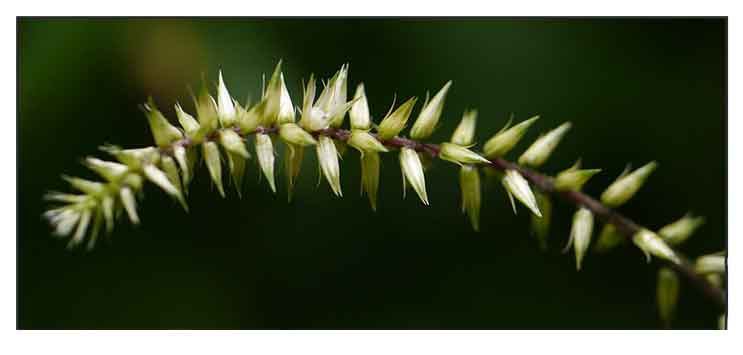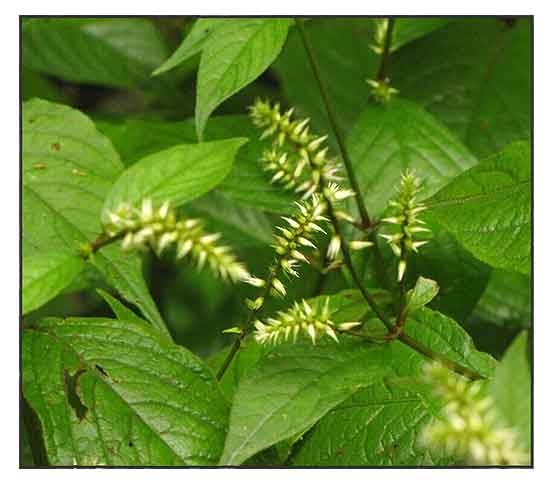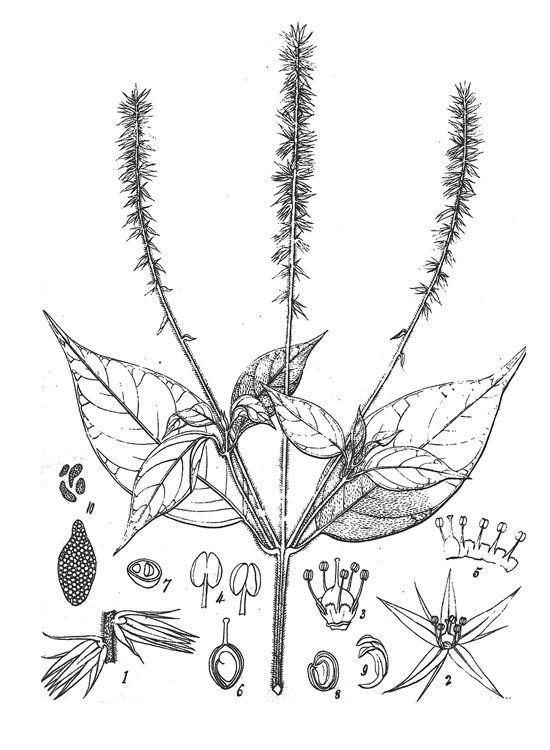 Gen info Gen info
- Achyranthes is a genus of medicinal and ornamental plants in the amaranth family, Amaranthaceae. Chaff flower is a common name for plants in this genus.
 Botany Botany
• Achyranthes bidentata is a perennial herb, 40-170 cm tall, stem quadrangular, furrowed, rather flaccid, thinly to densely pubescent, often purple in upper part. Leaves elliptical-oblong, lanceolate or ovate, 5-20 cm × 2-8 cm, base attenuate, apex mostly long acuminate, sparsely to densely velvety tomentose on both sides, petiole 0.5-3.5 cm long. Spike terminal and axillary in the upper leaf axils, 4-45 cm long, including 1-15 cm long peduncle, more or less whitish-tomentose, bract ovate-oblong, 3-3.5 mm long, apex acuminate, not pungent, margin ciliate, bracteoles spinescent, as long as perianth, 3.5-5.5 mm long, apex often recurved, basal wing inserted on lower part of spine. Tepals membranaceous, veins absent, acute, 4.5-7 mm long, not pungent in fruit, pseudo-staminodes truncate, dentate. Utricle oblong, 2-2.5 mm long. (1)
Distribution
- Native to the Philippines.
- Also native to Assam, Bangladesh, Borneo, Cambodia, Caroline Is., China, Hainan, Himalaya, India, Japan, Jawa, Korea, Laos, Lesser Sunda Is., Malaya, Maluku, Marianas, Myanmar, Nansei-shoto, Nepal, New Guinea, Nicobar Is., Ogasawara-shoto, Pakistan, Solomon Is., Sri Lanka, Sulawesi, Sumatera, Taiwan, Thailand, Tibet, Vietnam. (2)
 Constituents Constituents
- HPLC study of BuOH-soluble fraction of roots purified five compounds viz., β-ecdysterone (1), 25 R-inokosterone (2), 25 S-inokosterone (3), zingibroside R1 (4) and ginsenoside Ro (5). (see study below) (7)
- Study for flavonoids yielded five phenolic compounds by 2-D paper chromatgraphy, of which four were isolated in pure state, viz. guercetin-3–0-rutinoside (rutin), guercetin -3–0-glucoside (isoguercetin), kaempferol-3–0-glucoside (astragalin) and caffeic acid.
(9)
- Study of roots isolated two new phytoecdysteroids, (25S)-20,22-O-(R-ethylidene)inokosterone (1) and 20,22-O-(R-3-methoxycarbonyl)propylidene-20-hydroxyecdysone (2), together with six known phytoecdysteroids (3-8). (12)
- Study of roots isolated 16 compounds including three new ones (1-3): oleanolic acid 28-O-β-D-glucopyranoside-3-O-[β-D-glucopyranosyl-(1→3)-β-D-galactopyranoside) (1), methyl (8Z,11Z)-5,6,7-trihydroxytetradeca-8,11-dienoate (2), methyl (6E,11Z)-5,8,9-trihydroxytetradeca-6,11-dienoate (3), fulgidic acid (4), (9E,11E)-13-oxooctadeca-9,11-dienoic acid (5), (9Z,11E,15Z)-13-hydroxyoctadeca-9,11,15-trienoic acid (6), oleanolic acid 28-O-β-D-glucopyranoside-3-O-α-L-rhamnopyranosyl-(1→4)-β-D-glucuronopyranoside (7), oleanolic acid 28-O-β-D-glucopyranoside-3-O-β-D-glucopyranosyl-(1→2)-[α-L-rhamnopyranosyl-(1→3)]-β-D-glucuronopyranoside (8), oleanolic acid 3-O-β-D-glucopyranosyl-(1→2)-[α-L-rhamnopyranosyl-(1→3)]-β-D-glucuronopyranoside (9), oleanolic acid 3-O-α-L-rhamnopyranosyl-(1→3)-β-D-glucuronopyranoside (10), blumenol C glucoside (11), citroside A (12), 6S,9S-roseoside (13), ginsenoside Rg1 (14), 20-hydroxyecdysone (15), and benzyl α-L-rhamnopyranosyl-(1→6)]-β-D-glucopyranoside (16), (see study below) (20)
Properties
- Roots considered anodyne, anti-inflammatory, antirheumatic, bitter, digestive, diuretic, emmenagogue, and vasodilator (5)
- Caution: The herb can cause dilation of the cervix and should not be used when pregnant. (4)
- Studies have suggested immunomodulatory, metastatic chemopreventive, antiobesity, neuroprotective, anti-inflammatory, anti-osteoporotic, α-glucosidase inhibitory, antidiabetic, antimalarial, anti-anxiety, antidepressant properties.
Parts used
Leaves, roots, stems, juice.
Uses
Edibility
- Seeds used as cereal grains in famine years.
- Seeds used for making bread.
- Leave reportedly edible; used like spinach.
Folkloric
- In Malaysia, leaves chewed for malignant mouth ulcers. In Papua New Guinea, heated leaves eaten with salt to relive abdominal pains and to kill hookworms and other intestinal parasites. (1)
- In China and Vietnam, roots used as diuretic and emmenagogue, for rheumatism, to facilitate delivery, and for vaginal discharges. (1)
- In Nepal, root juice used for toothache.
- In India, used externally for treatment of leech bites. Decoction used as diuretic. (3)
- During the Chinese Liang dynasty, the plant was used as an abortifacient. Juice from crushed plant is inserted into the vagina to induce abortion. (3)
- Root juice used for treatment of indigestion and asthma. Stems used for treatment of pyorrhea. Herb used for treatment of hypertension, back pains, dizziness, hematuria, epistaxis, amenorrhea, dysmenorrhea, bleeding, strangury, etc. (4)
- Used for various diseases including amenorrhea, dysmenorrhea, lumbago, gonalgia, paraplegia, edema, stranguria, headache, dizziness, odontalgia, hematemesis, epistaxis, oral ulcers.
Others
- Veterinary: In Java, plant used as vermifuge for horses. (1)
- Stems: Used as toothbrush.
Studies
• Protective Against Antimycin A Induced Damage of Osteoblastic MC3T3-E1 Cells / Root: A. bidentata is an herb used in traditional medicine for strengthening bones and muscles and ensuring flow of blood. Study evaluated the effect of root extract (AE) on osteoblast function in osteoblastic MC3T3-E1 cells. AE caused significant elevation of alkaline phosphatase activity, collagen synthesis, osteocalcin production, and mineralization in the cells (p<0.05). AE decreased production of TNF-α, IL-6, and RANKL induced by antimycin A, mitochondrial electron transport inhibitor. Exposure of MC3T3-E1 cells to antimycin A caused significant decrease of cell viability and mineralization. Pretreatment with AE significantly reduced cell damage by preventing mitochondrial membrane potential dissipation, ATP loss, ROS release, and nitrotyrosine increase, suggesting AE may be useful for protecting mitochondria against burst of oxidative stress. Results suggest potential for preventing osteoblast damage in the elderly. (5)
• Immunomodulatory / Polysaccharide: Study evaluated the underlying mechanism of immunomodulatory activities of Achyranthes bidentata polysaccharide (ABPS). Results showed ABPS significantly increase secretion of IL-1ß and TNF-α in J744 A.1 cells. Nitric oxide (NO) was significantly increased after treatment. Activation of TLR4 antibody and CD14/TLR4 antibody were significantly decreased. Pyrrolidine dithiocarbame (PDTC), a specific inhibitor of NF-kB, remarkably inhibited the secretion of IL-ß and TNF-α induced by ABPS in J744 A.1 cells. ABPS promoted NF-kB translocation into the nucleus. The mRNA and protein expression of TLR4 and MyD88 were significantly increased after ABPS treatment. Findings suggest the immunomodulatory mechanism of ABPS is associated with the secretion of cytokines stimulating the NF-kB pathway through TLR4/MyD88 signaling. (6)
• Metastatic Chemopreventing / Root: Recent biosystems revealed similarities between embryonic implantation and cancer cell adhesion, suggesting abortifacients may be good for safe and effective metastatic chemoprevention targeting circulating tumor cells (CTC). The hypothesis was tested using A. bidentata. Of five compounds separated from the root, ginsenoside Ro was the most potent in inhibiting embyonic implantation within non-cytotoxic concentrations. It inhibited metastatic dissemination capability of colon cancer cells HT29, including migration and invasion ability, and adhesion to human endothelium through inhibition of αvß6, MMP-2, MMP-9 and ERK phosphorylation by HT29. Pretreatment of nude mice with oral ginsenoside Ro followed by HT29 intravenous inoculation and 40-day oral gRo significantly prevented lung metastasis with downregulation of integrin αvß6 and no toxicity. Study introduces a new concept of utilizing safe and effective abortion botanic medicines for CTC-based metastatic chemoprevention. (see constituents above) (7)
• Inhibition of Adipogenesis / Antiobesity Effect / Root: Study investigated the antiobesity effect of A. bidentata root water extract in a 3T3-L1 adipocyte differentiation model and rats fed with a high fat diet. Results showed A. bidentata root inhibited 3T3-Li adipocyte differentiation without affecting cell viability, with no significant change in perilipin expression. There was significant reduction of body weight without affecting food intake. Triglyceride level was significantly decreased. Results suggest the root water extract has beneficial effect on inhibition of adipogenesis and control of body weight in rats fed with a high-fat diet. (8)
• Protective / Experimental Sciatic Nerve Crush Injury: Study evaluated the effects of aqueous extracts (ABPP) administration on peripheral nerve regeneration in a mouse sciatic nerve crush injury model. Daily tail vein injections of 1, 4, and 16 mg/kg ABPP were administered for 21 days. Results showed treatment with ABPP at dose range of 1-16 mg/kg promoted histological regeneration and functional recovery of injured sciatic nerve and its target muscle, with efficacy greater than that by vehicle treatment and close to methylcobalamin (65 µg/kg). Results suggest plant polypeptides, ABPP, may have potential for ameliorating neuropathy caused by sciatic nerve crush. (10)
• Alleviation of Disuse-Induced Muscle Atrophy / Saponins: Roots have been used in traditional Chinese medicine for muscle and bone strengthening. Study evaluated the anti-muscle atrophy effect of A. bidentata and possible signaling pathways involved. Saponin root extract (ABSE) was orally administered at dosages of 35, 70 and 140 mg/kg/day to disuse-induced muscle atrophy mice. Total saponin content of ABSE was 59.1%. ABSE promoted the C2C12 cells differentiation to myotube in C2C12 differentiation assay. In the disuse-induced muscle atrophy mice model ABSE significantly increased muscle fiber diameter and proportion of slow muscle fibers. Transcription analysis revealed the ABSE alleviated muscle atrophy at least through activation of P13K/Akt pathway in vivo and vitro. Results suggest considerable potential in the prevention and treatment of muscle atrophy. (11)
• Effect on Carrageenan-Induced Prostatitis: Study evaluated the effect of A. bidentata on carrageenan-induced chronic prostatis in rats. In CNP (chronic non-bacterial prostatitis) model, the extract decreased PI (prostatic index) and PSA (prostate specific antigen) compared to untreated control. Morphometric analysis showed significant reduction in chronic inflammatory cell infiltrates and interstitial fibrosis. Reduced values of TNF-α, IL-ß, COX-2, PEG2 were observed. Levels of TGF-ß1 and CTGF in extract-treated groups were significantly lower. There was also alleviation of the inflammatory state of the prostate gland (p<0.05). Results suggest a potential treatment for chronic prostatitis. (13)
• Effect on Proliferation of Schwann Cells / Peripheral Nerve Regeneration / Polypeptide K: Achyranthes bidentata polypeptide K (ABPPK) is an active ingredient isolated from A. bidentata polypeptides. Study investigated the promoting effects and molecular mechanisms of ABPPK on the proliferation of Schwann cells (SCs). Weighted gene co-expression analysis (WGCNA) showed that ABPPK was mainly involved in the positive regulation of cell proliferation and epigenetic regulation of cell proliferation and positive regulation of cell cycle. Functional enrichment analysis showed ABPPK had more advantages and participation in the axon extension and vascular system areas. ABPPK significantly promoted the proliferation of SCs invivo. Results further enrich the understanding of function and molecular mechanism of ABPPK in peripheral nerve regeneration, which are conducive to the discovery of new therapeutic targets for peripheral nerve regeneration. (14)
• Neuroprotective / Intravenous Polypeptide Supports Stroke Recovery: Previous studies have shown ABPP have neuroprotective function in vitro and in rat middle cerebral artery occlusion (MCAO) model in attenuating the brain infarct area induced by focal chemise-reperfusion. In this study, intravenous ABPP after MCAO decreased the neurological deficit score, ameliorated the forepaw muscle strength and diminished the motor and sensory disturbance of spatial learning and memory in rats. Results showed APBB could improve recovery of sensory, motor coordination, and cognitive function in MCAO-induced ischemic rats. (15)
• Enhancement of Anti-Malarial Immunity during Plasmodium yoelii Infection / Polysaccharides: Polysaccharides (ABPS) possess immunomodulatory functions. Study evaluated whether pretreatment with ABPS using a rodent malaria of Plasmodium yoelii 17XL will modulate host immunity against malaria infection and improve outcome. Results showed pretreatment with ABPS prior to infection significantly extended survival time of mice after P.y 17XL infection. Immune response against malaria infection was evidenced by significantly higher numbers of F4/80+CD36 macrophages and levels of IFN-γ, TNF-α and nitric oxide than control. ABPS-treated mice developed more myeloid (CD11c+CD11b+) and plasmacytoid dendritic cells (CD11c+CD45R+/B220) than control. Results showed pretreatment with the immunomodulatory ABPS selectively enhanced Th1 immune responses to control the proliferation of malarial parasites, and prolonged survival of mice during subsequent malaria infection. (16)
• Effect of Polysaccharides (ABP) on Physical Fatigue: Study evaluated the effects of A. bidentata polysaccharides (ABP) on physical fatigue in mice, using forced swimming test and measuring biochemical parameters related to fatigue. Result showed ABP had clear anti-physical fatigue effects, which could extend exhaustive swimming time of mice, as well as increases in liver glycogen and muscle glycogen content and decreases in blood lactic acid and blood urea nitrogen levels (17)
• Anti-Osteoporosis / Stimulation of Bone Formation / Polysaccharide / Root: A. bidentata polysaccharide (ABPB), extracted with alkali from roots of A. bidentata, significantly increased the bone mineral density, bone mineral content, trabecular thickness, trabecular number, and biomechanical properties of ovariectomized (OVA) rats, indication prominent curative effect of ABPB on osteoporosis in OVX rats. A novel polysaccharide (ABPB-3) was purified from ABPB, which was also shown to stimulate bone formation activity. Study suggests ABPB and ABPB-3 have potential for use as anti-osteoporosis medicine (18)
• In Vitro Osteogenic Activity of ABPB-4 / Rhizome: Study of A. bidentata rhizome isolated and purified a pectic polysaccharide (ABPB-4), which significantly promoted the proliferation, differentiation, and mineralization of MC3T3-E1 cells in vitro, and appreciably enhanced mRNA ion of osteogenic-related genes in these cells. Results indicate ABOB-4 has outstanding osteogenic activity, with potential as anti-osteoporosis agent. (19)
• Anti-Inflammatory / α-Glucosidase Inhibitory / Roots: Study of roots isolated 16 compounds including three new ones. Compounds 1, 7, and 11-16 inhibited NO production in LPS-activated RAW264.7 cells with IC50s in range of 28,03 to 54.23 µM. Compounds 14 and 15 showed anti α-glucosidase activity with IC50 of 176.24 and 156.92 µM, respectively, compared to acarbose IC50 160.99 µM. (see constituents above) (20)
• Antianxiety / Anti-Depressant / Leaves and Roots: Study evaluated the anti-anxiety and anti-depressant potential of methanolic extract of A. bidentata leaves and roots using standardized mouse models of anxiety and depression. Elevated Plus Maze test (EPM) and Open field test (OFT) were used to assess anxiolytic activity and Modified Forced Swim test (MFST) and Tail suspension test (TT) to assess anti-depressant activity in Swiss albino mice. Root extract showed higher anti-anxiety and anti-depressant activity due to high amount of flavonoid. (21)
• Bidentatide / Neuroprotective: Study on Achyranthes bidentata identified an NMDA receptor subtype 2B (NR2B) antagonist, a 33 amino acid peptide named bidentatide that exerts distinct neuroprotective actions. Neuroprotective potential was evaluated invitro against NMDA-mediated excitotoxicity. Results showed pretreating primary cultured hippocampal neurons with bidentatide prevented NMDA-induced cell death and apoptosis via multiple mechanisms that involved Ca2+ inhibition, NMDA current inhibition, and apoptosis-related protein expression regulation. Mechanisms were all dependent on bidentatide-induced inhibitory regulation of NRA2B-containing NMDA receptors. Study suggest bidentatide may contribute to the development of neuroprotective agent that could possess high selectivity and safety profile inherent in peptide drugs. (22)
• Ooteoporosis Treatment / Components and Mechanisms: Study evaluated the potential effective components and mechanism of A. bidentata in the treatment of osteoporosis. A total of 19 effective components were screened from A. bidentata, with 32 intersecting targets between effective components and osteoporosis disease. The main effective components of A. bidentata in the treatment of OP are quercetin, kaemferol, wogonin, baicalein and palmatine. Mechanism may be associated with cell differentiation and apoptosis, metabolism, inflammation reaction, etc. Study suggests multicomponent, multi-target and multi-system characteristics. (23)
• Antitumor / Bidentata Polysaccharide: Study isolated A. bidentata polysaccharides (ABPS) and evaluated its antitumor effect on LTEP-a-2 cells. ABPS significantly inhibited the proliferation and apoptosis of LTEP-a-2 cells. Results suggest a new potential therapeutic agent against lung adenocarcinoma. (24)
• Anti-Inflammatory: Study evaluated the anti-inflammatory activity of alcoholic extract of A. bidentata on carrageenan-induced hind paw edema and cotton pellet granuloma models in Swiss male rats. Diclofenac sodium was used as standard drug. The extract at 375 and 500 mg/kg showed maximum inhibition of edema by 63.52% and 79.73% at 3 hr in the acute model. In the chronic test using granuloma pouch in rats, the extract exhibited 50.76 and 57.49% reduction in granuloma weight. Results showed A. bidentata possesses acute and sub-acute anti-inflammatory effects. (25)
• Osteoprotective in Steroid-Induced Osteonecrosis: Study evaluated whether A. bidentata extract can prevent steroid-induced osteonecrosis of the femoral head (ONFH). Extract treatment could improve trabecular bone microstructure, increase bone mineral density and promote vascularization in steroid-induced ONFH rats. ABE inhibited osteoclasst differentiation and activated bone markers, and reversed OPG downregulation, RANK and RANKL upregulation, which effectively inhibited RANKL-induced osteoclast differentiation and regulated RANKL and OPG expression invitro. Results showed AB extract can prevent steroid induced deterioration by regulating the RANKL/RANK.OPG signaling pathway. (26)
• Antidiabetic / Synergism with Verbascum thapsus: Study evaluated the synergetic activity of A. bidentata and Verbascum thapsus in alloxan-induced diabetic albino mice. Daily administration of Ab (300 mg/kg) and Vt (300 mg/kg) and combined dose (600 mg/kg) significantly (p<0.05) decreased the fasting blood glucose levels, improved body weight, lipid profile, liver and kidney function, and controlled diabetes after 35 days of treatment. A. bidentata was found more effective than V. thapsus, while the combined extract dose was highly significant (p<0.001). (27)
• Analgesic / Polysaccharides: Study reports on the optimal extraction of polysaccharides from Ab and evaluated its analgesic effects using acetic acid writhing reflex. Optimal extract was temperature of 90°C, 3.5 h, and ratio of water to rat of 40:1, with resultant yield of 5.48%. The ABPs decreased the number of writhing reflex and increased writhing reflex incubation period in mice. The ABs did not show any toxic reactions. (28)
Availability
Wild-crafted.
Seeds in the cybermarket.
|

![]()






